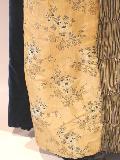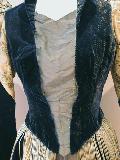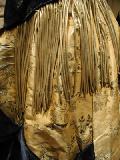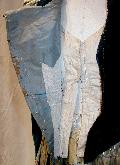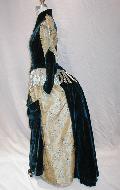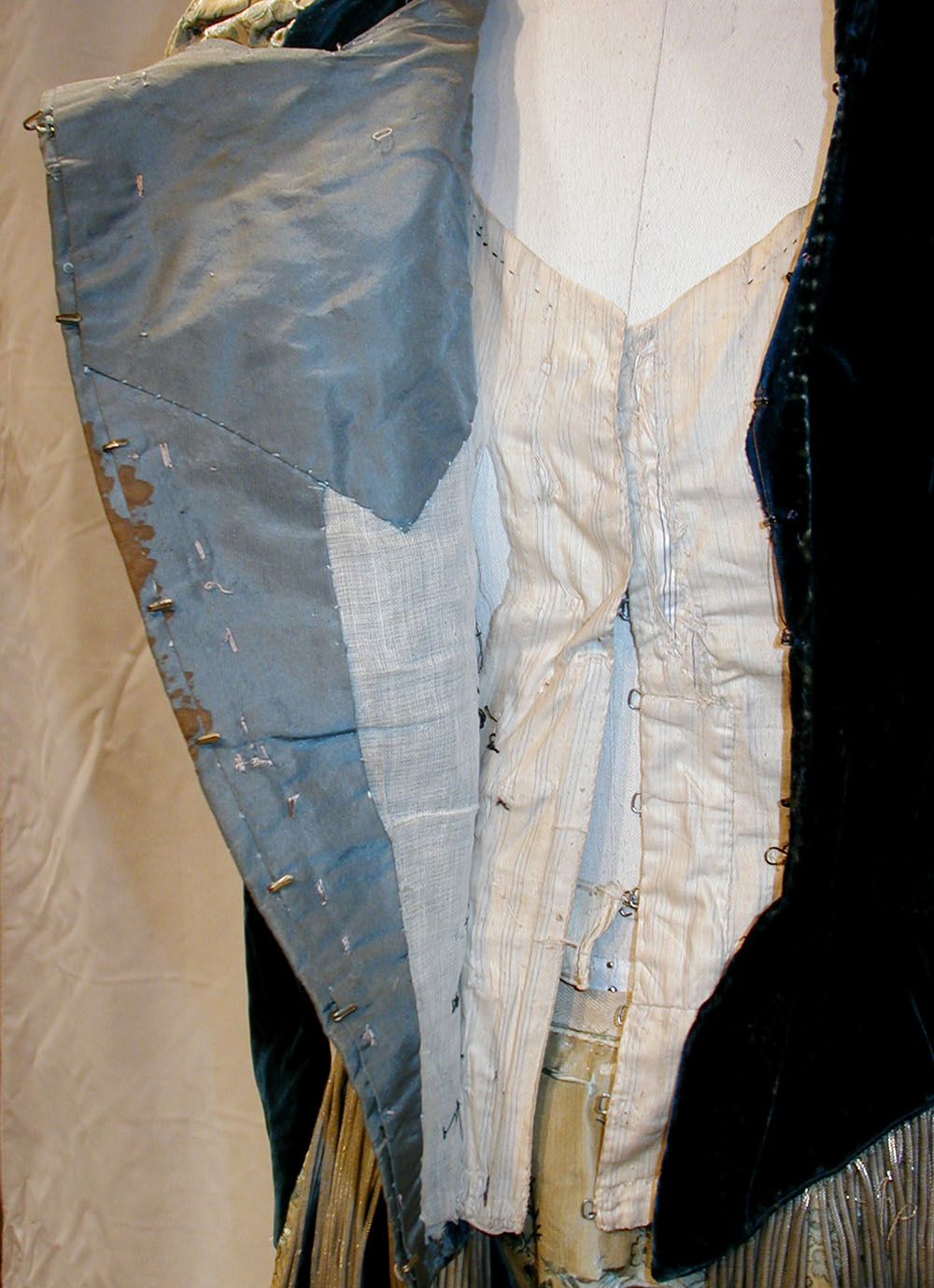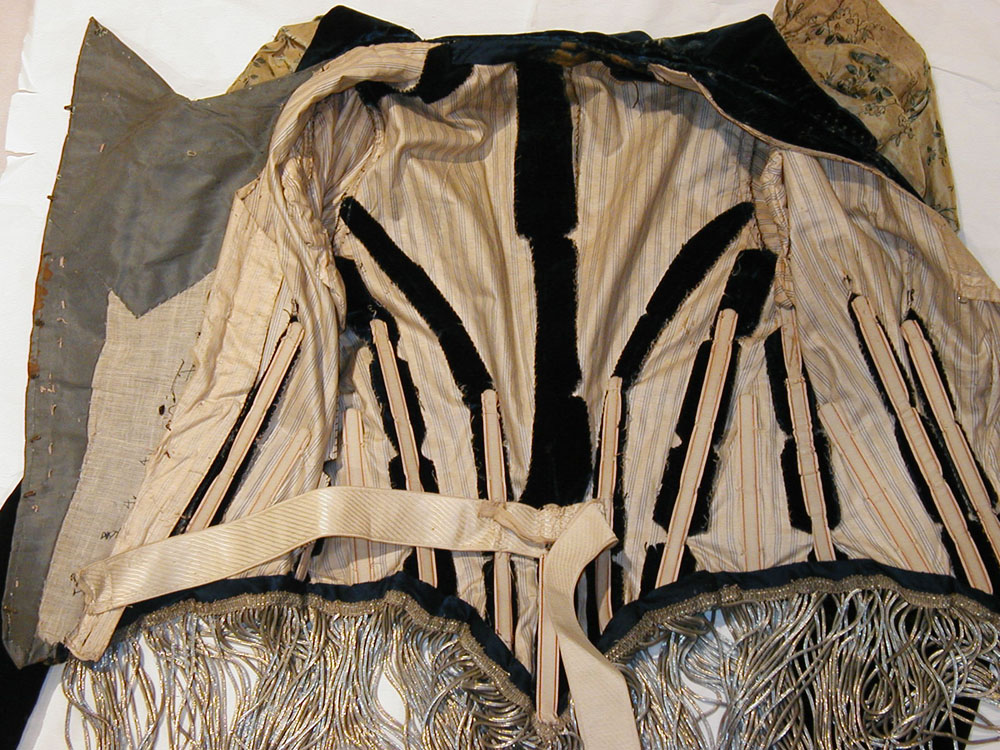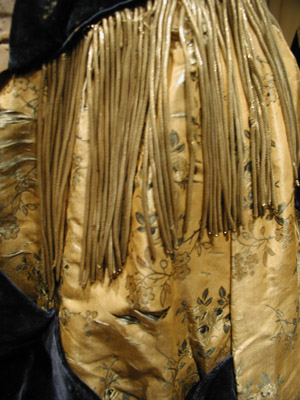This lovely ensemble consists of a skirt and boned bodice. The bodice is made from navy blue silk velvet, gray/green silk faille, and a muted yellow brocade with a floral pattern with similar gray/green colors as the faille. It is dated c.1887-1890 for a number of reasons. Through my research, I have found that leading up to this style were the larger bustles in the skirts as well as smoother caps in the sleeves. Around 1887, the sleeves gained some fullness in the cap with a high, arched cap and a fitted lower arm, but by 1890 the sleeves really began to inflate and were headed for the full leg 'o mutton by 1895. Center front inserts were popular in jacket-style bodices around 1890 as well as the fact that the closed standing collar, which appeared before and after this time, loosened up a bit around 1890 and showed a portion of skin at the neck, even in day wear. Around 1890, the skirts had reduced the largest bustle cage but gained a smaller pad and a train. A practical woman could remove a bustle cage (or the bones inserted into her petticoat to create a fuller bustle,) and add a small pad, to end up with a train but still have the roundness in the hips and from the back that was attractive at the time.
The skirt is asymmetrical in design which was typical of the entire bustle period and into the late 1890s. Another aspect that leads to the date c.1887-1890 is the fact that the center back of the skirt is not overly ornate. The decline of the bustle had occurred and therefore ornate decorations on skirts were no longer as popular. This skirt simply has pleated velvet in deep folds that add fullness to the round portion of the back as well as fullness in the train. I believe this is a winter day dress because of the weight and colors of the fabric.
Bodice Construction
The main body of the bodice is made of navy velvet, and has a standing collar. It ends in an attractive point at the bottom of center front, and a dramatic point at center back. The bodice is made up of eight pieces plus the center front inset, and has a slenderizing waist shaping in all the pieces. On each half, it has a side front panel with two darts, a side panel, a side back panel, and a center back panel. The shoulder seam drops to the back at the armscye edge, 2" from the shoulder point. The side front pieces have two darts for shaping, the shortest one closest to center front. There is a seam coming out of the armscye that ends up parallel to center back from the bottom 5". The other side back seam points more dramatically towards the center back for the bottom 2", but overall it is shaped more on a diagonal.
Gray/green silk faille is the fabric of the center front inset, and the color of it matches the flowers and leaves in the brocade of the sleeves and skirt. This panel narrows from a width of 5" at the top to 1 1/4" at the point. The center front inset was originally 11 1/2" long. This piece was stiffened with tarlatan and originally had seven short rows of slightly overlapping 1 1/4” metallic bullion fringe. These rows were removed when this garment was still being worn on stage before the Department of Dramatic Art created the Costar Archive (collection of vintage garments). There is an additional piece of faille, 3 1/2” high, added on top of the center inset. The seam of the two would have been hidden by a row of the bullion trim. There is a small dart in the bottom of the center front inset, approximately 4 1/2" long. The back of the inset has had the hooks sewn on, and then the base is covered over with a facing 3" at the top, narrowing to 3/4" wide at the bottom. The top 6" of the inset is also faced with a separate piece of faille and it is slip-stitched in place. There are 15 thread loops on the inset that correspond to the left side front pieces of velvet all the way up the neckline where hooks are attached.
The collar is covered in velvet and has stiffener in it, possibly tarlatan. It has been stitched on by hand with somewhat large stitches which indicate that it was possibly a later addition since it is loosely attached. It starts just above where the original style line of the inset is. It was not changed when the inset was heightened. The edge of the bodice around the neck (discounting the collar) is folded back to form a self-facing. At the body's left side an organdy stiffener is added, and then 15 hooks are stitched through the velvet that will hook to cloth eyes on the edge of the center inset. It is not tacked back in place, just folded. There is thin cording along the bottom edge of the bodice body all around in a matching navy satin.
Internal Bodice Construction
The entire bodice is flat-lined with striped cotton. Each of the front lining pieces has an extension that hooks at center front and gives strength as well as releases the pressure from the faille vest-like inset that hooks on the left side. There is a short bone placed on the body’s right side in the edge of the lining that overlaps in front to give stability to the area where the hooks are placed. The hooks used on this internal portion are unusual in that they are labeled "Nicholl's" and are longer than modern hooks. The eyes get locked-in because pressure must be applied to release them from the hook. The eyes are like modern ones and extend beyond the edge of the under piece of lining (the body's left half). There are nine hooks and eyes down the center front of the lining. The lining in the center front is just turned back and slip-stitched to finish the edge. The bottom of this area is finished straight across rather than following the point of the inset piece. The top of this piece has a "V" shape to it that mirrored the original "V" of the inset and was not changed when the inset was heightened. There has been some reinforcement of the lining fabric added later to this area on the body’s right half and is obvious in the picture.
| Image 1: Inside lapel | Image 2: Front Closure | Image 3: Boning and inside construction |
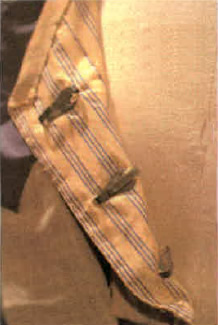 |
|
|
Also the bodice has bones tacked down on each seam allowance and dart as well as a bone between the dart and side seam and between the side seam and side back seam. This is the case on each side. The seams and armscyes have been machine-stitched and the seam allowances overcast by hand. The seam allowances have been clipped at the waistline to release the pressure on the seam allowance. Where the bodice curves, the seams have been rounded and hand overcast. The striped cotton also lines the sleeves and is used for the "pit pads" to prevent any perspiration from damaging the bodice.
The center back portion of the bodice neck edge, from shoulder seam to shoulder seam, has been finished with a bias piece of navy satin stitched to the back unfinished edge then turned down and slip-stitched in place. This bodice has a 2” waistband attached at the inside center back that hooks in front. It has a loop under the band to hook the skirt to the bodice at center back.
Sleeve Construction
The upper portion of the left sleeve is yellow brocade (see Image 1). It is cut in one piece on the bias with fullness concentrated at the top of the armscye with small cartridge pleats. It has a high cap. The lower portion of the sleeve is velvet and is constructed in two curved pieces. The front piece has a point at the top that some of the upper sleeve fullness is gathered into. There is no cuff. The portion of the front velvet piece that wraps around is gathered in to the thinner portion of the lower velvet sleeve at the back seam. There is an opening at the inside front edge of the sleeve about 1 1/2" long and faille fabric from the center front inset is used as a facing there on the inside of the sleeve and is about 2 1/2" wide. There is thread still on the end of the sleeve that indicates some sort of trim was once there.
| Image 3: Sleeve | Image 4: Sleeve Cap |
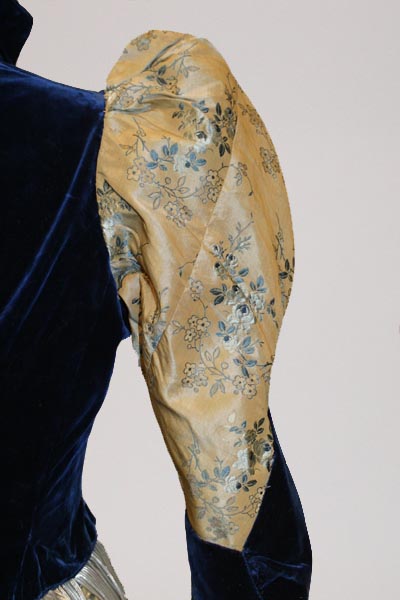 |
|
The inside of the sleeve is constructed of two pieces. The front part of the sleeve is curved with some fullness at the top and there is some fullness concentrated at the elbow. The back piece is narrow and curved, wider at the elbow. The sleeve is constructed in a complex manner. The inside arm or underarm seam has the outer and inner fabrics flat lined together and stitched, leaving the 1 1/2" opening at the wrist. Then the outside seam has the pieces stitched together up about 6” and then the upper portion of that outer lining seam is stitched together above the opening, turned in on itself and overcast. This is done because the outer sleeve does not have a seam in the upper brocade part, but the lower portion of the outer sleeve, the velvet part, does have a seam. The bullion fringe at the top of the sleeve cap provides contrast with the textures of the sleeve and bodice.
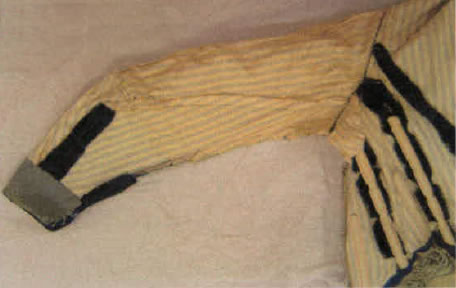
Underskirt Construction
The underskirt consists of four pieces of stiff cotton (perhaps linen) and a woven cotton waistband 5/8" thick; it is folded in half. The waistband was machine stitched to the seam line of the cotton and then flipped up and the seam allowance was folded down away from the waistband and hand overcast through all which helps hold the waistband up in place. There is a large (size 6) hook and eye to close the waistband as well as another hook 1 1/2" from the opening that is positioned hook portion up that attaches the skirt to the bodice. In the underskirt there is a center front panel, two side pieces and a center back. As evident in Photo 14, all of the pieces have a seam allowance at the top that has been pinked with 1/4" "V"s and then stitched in place when the outer skirt was attached to the underskirt. There is an opening on the left side of the center back pieces that is 9 1/2" long.
Both of the side pieces, although basically the same shape, have some differences. Each side piece has been repaired near the hem and although both have pleats to control their fullness at the top, they are different on each side. Each of the side pieces also has two appliqued pieces of cotton that are above the top two strap placements. I am unsure of the usage of these pieces. The seams of the underskirt have not been finished but left raw.
The top of the center back of the skirt has been folded down to finish the top edge. This portion of the skirt was then cartridge pleated into 1 3/4" with 1/4" pleats at the waist on each half. There has been an extra piece of muslin added to the upper portions of center back that is 2 1/4." There is evidence of stitching lines in multiple places across center back that, I believe, indicate where bones casing once where used to create the full bustle shape down the skirt. There are four paired sets plus a single row and the bone that remains cross-stitched in place about 1/3 of the way down. There is an extra piece also added to the right half of center back, probably because of a lack of fabric. There is 3" horsehair along the bottom of the back pieces covering the side back seams and just below the seam of the velvet pleats. There are also three straps placed on either side of the back pieces that were tied together to create the bustle shape when the bones were originally included and would still add some fullness in the back even without the stiffness of the bones. The straps are 14 1/2" long with 9 1/2" of 1/2" cotton Prussian tape and 5" of 1/2" elastic closest to the seam. The elastic was probably added at a later date.
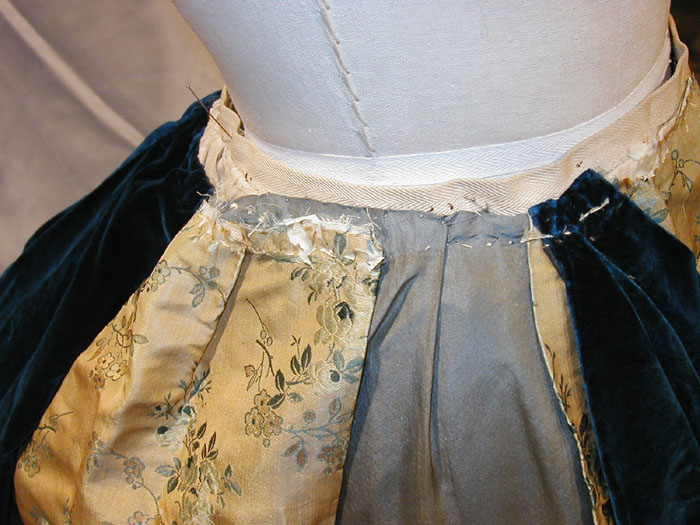
The outer skirt has been hand-tacked through to the underskirt in various places indicated on the gridded pattern. Also, six inches up from the bottom of the cotton underskirt is a line of hand stitching all around the skirt, except for the center back pieces, where the outer skirt has been tacked in place. At the bottom of the cotton skirt are nine sections of fabric that are 2 3/8" long velvet. Out of those pieces, there are 65 total pleats at 1 1/2" wide with a 1/2" return. The pleated portion is stitched to the bottom of the cotton, graded and then covered with a braided 1/2" wide tape by machine stitching. The bottom portion of the pleats have been finished with 1/2" wide silk hem tape, attached by hand before the pleats were created. The underskirt hem has an inner circumference of 80 inches.
Overskirt Construction
The overskirt is made of eight pieces. Only the center back pieces and center godets are symmetrical from side to side. The full width of the velvet was used and then identical godets were added at the bottom of the center back panels to add fullness. There is a front piece that is the muted yellow brocade with the floral pattern flat-lined to organdy along the hem and up 6 inches. It is wider on the left side of true center front than on the right side of the pattern piece. It has a piece of velvet arranged diagonally over it and is pleated in two places to create it’s shape. On the right side of the front piece is a thinner piece of faille that has a pleat at the top and then has nine rows of 3 1/2" long bullion that lead to the floor. There are two side back pieces of brocade that have two pleats at the top and is also flat-lined with organdy just over 6" from the hem. This organdy is stitched through to the underskirt all around except for the center back pieces.
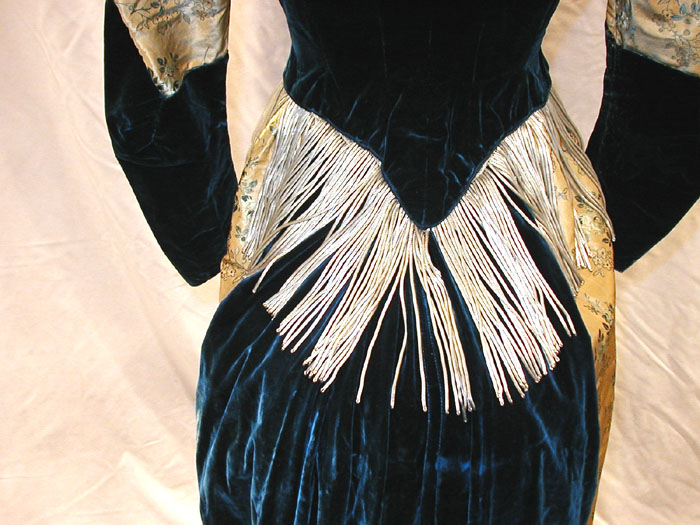
The center back pieces are made of navy silk velvet and are wide as well as having two godet pieces added to the lower center back seam. There are three pleats at the top of each piece with the outside one being the widest and being folded over the other two. The opening of the skirt is on the left back side. Attached to the overlap (velvet side) of the opening are two more Nicholl's (see note above under "Internal Bodice Construction") hooks that attach to two eyes on the placket underlap that is made of brocade. The entire overskirt is attached to the underskirt by hand around the top of the underskirt below the waistband. The top edge of the overskirt fabrics are not finished. This rough waistband area of the skirt is covered by the bodice when it is worn; the bodice would not have been removed.
Damage
The brocade pieces show the most deterioration of the entire garment. The center front pieces of the velvet on the skirt also have some discoloration and spotting. The original bullion trim on the bodice inset has discolored the left half of the velvet in the bodice when it was improperly stored. Much of the bullion trim on the bodice has been removed. There is a similar discoloration in the faille inset. There is some deterioration and fractures in the brocade of the sleeves.
Pattern
The pattern were achieved using gridded pellon that was gently pinned and sewn to the original and then traced. After this step was completed, the grid was transferred by hand to 1/8" graph paper. The bodice was reproduced using couture techniques in contemporary fabric to fit a modern body.
©Iisha Lemming, 2005


